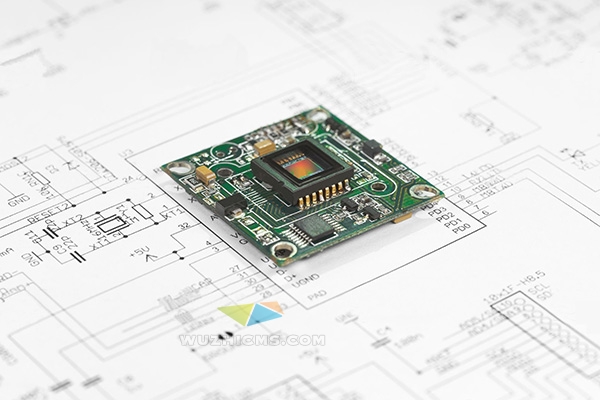• A drill symbol chart is required. This chart depicts your finished hole sizes and associated hole size tolerances. A finished hole size of +/- .003” is typical for plated through hole (PTH), and can be +/- .002” for non-plated through hole (NPTH)
• A dimensional drawing is required. All critical dimensions must be noted and the rigid to flex interfaces (where the rigid material stops and the flexible material begins) must be defined. Typical outline tolerances are +/- .006” for flex circuit and +/- .010” for rigid-flex. If a pallet or array is required, a dimension view must be supplied for this as well.
• A board construction and layer order is also required. This should show which layers are rigid material and which layers are flexible material including copper weights.
• A drawing revision table is advised. Your company name, part number, current revision should be in the title block area of the drawing.
Drawing Requirements:
• Cross-section diagram (material stack-up)
• Outline drawing of circuit
• Material listing (base material, coverlay, stiffener, adhesive, etc)
• Specifications
• Hole chart
• Dimensional tolerances
• Feature chart (minimum conductor width and spacing, minimum spacing requirements)
• Special plating requirements
• Marking requirements
• Testing requirements
• Special packaging requirements

What To Include In Flex Drawing Notes
• The PCB shall be fabricated to IPC-6013, class (your requirement here, normally 2, highest class is 3), wiring type (your requirement here), and installation use (your requirement here) standards.
• The flexible copper clad material shall be IPC-FC-241/11preferred (or /1) (flexible adhesiveless copper clad dielectric material). Example: Select Dupont FR / AP / LF series, and if no special requirement, we will use alternative brand instead of Dupont, s in Mainland China, it’s not easy to get Dupont material in short time (normal lead time is 6-8 weeks for Dupont)
• The coverlay material shall be per IPC 4203/1 (your requirement here). Example: LPI (mentioned color such as Green, white, black, etc) or Coverlay
• The maximum board thickness shall not exceed (your requirement here) and applies after all lamination and plating processes.
• For Rigid-flex Constructions: The thickness of acrylic adhesive through the rigid portion of the panel shall not exceed 10 % of the overall construction.
• Min. thickness of plated through-holes is .004” (10um), with a minimum annular ring of 2 mils.
• Vacuum press in autoclave or vacuum lamination
• Misregistration between any two layers shall not exceed ±.005.
• Warpage shall not exceed .010 inch per inch (unlike rigid PCB, it’s not easy for flex circuit to control that parameter)
• Copper Plating in plated through-holes shall be .0004 (10um) minimum thickness.
• If Using FR4 Material in Rigid Section: The rigid material shall be GFN (FR4) per IPC-4101/24.
• If Using Polyimide Material in Rigid Section: The rigid material shall be GIN (Poly) per IPC4101/40.
• If Thickness Is Critical, Add: The flexible section thickness shall be (your requirement here).
• Finish: All external conductive surfaces not covered by solder mask shall be plated with ENIG (1u” Au), or different gold thickness (1-3u”), or different surface finishing type (Tin Immersion, ENEPIG).
Additional Requirements:
• Marking and identification requirements here.
• Electrical test requirements here.
• Packaging and shipping requirements here.
If Required:
• Apply green LPI soldermask in the rigid sections of the board over bare copper on both sides. All exposed metal will be (surface finish requirement here).
• Silkscreen both sides of the board using white non-conductive epoxy ink.
• The PCB shall be constructed to meet a minimum flammability rating of V-0.
CAD data guidelines
BEST TECH can accept CAD data in the following forms
•Gerber RS-274X format (embedded aperture) photo plotter code is preferred.
•RS-274D Gerber data with separate, detailed aperture list can be used, but is not preferred.
•AutoCAD DXF (2D)
•AutoCAD DWG (2D)
Other formats may be acceptable — contact BEST TECH for details.
Transferring data to BEST TECH
You can transfer your media to BEST TECH in the following forms, which are listed in order of preference.
•E-mail: Contact Access: BEST TECH Sales and Support at +86-755-29091601, sales@bestfpc.com
•Zip disk, or CD: IBM-PC format
Guidelines for all formats
•Single entity draws for conductors are required.
•Single pad flashes are required.
•Minimize the entities used to create conductor to pad transitions (“fillets”).
Guidelines for DXF
•Place artwork data, part outline, hole centers, soldermask, coverlay, screen marking, etc. on separate, individual CAD system layers.
•Polygons or zero width line draws for irregular pad shapes and shield area outlines are preferred (instead of filling in these shapes).
•Supply arcs and circles. Do not convert arcs or circles into segmented lines.
•Avoid supplying only conductor outlines, as it increases set-up cost. If you do supply conductor outlines, include supporting CAD system layer with proper line width conductors and pads.
Guidelines for Gerber
When sending your photo plotter code, please include:
•The format of the data
•An aperture wheel listing (when required)
•A list of layers with descriptions
•The number of files supplied










 2022-10-27
2022-10-27
 BEST
BEST

.png)
.png)
.png)
.png)

.png)

